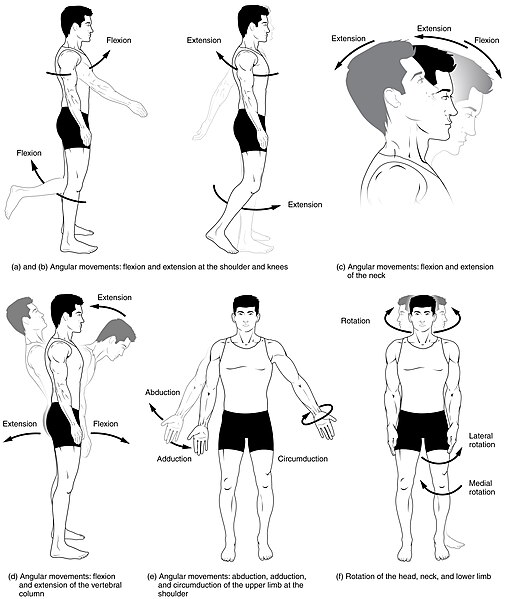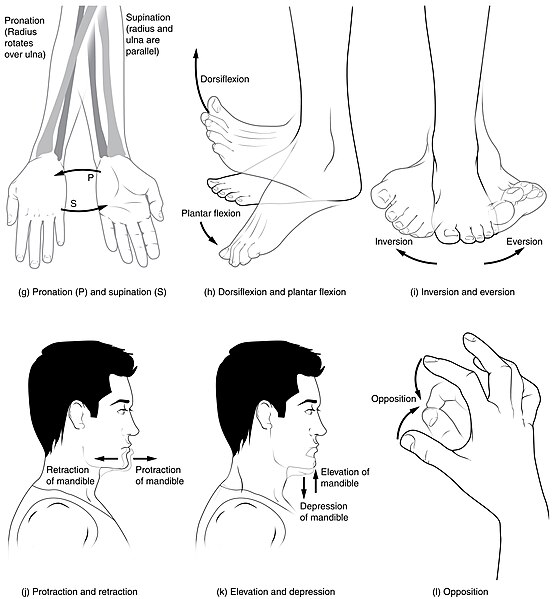14.5 Physiology of the Muscular System
The main function of the muscular system is movement. Muscles work as antagonistic (opposing) pairs. As one muscle contracts, another muscle relaxes. This contraction pulls on the bones and assists with movement. Contraction is the shortening of muscle fibers whereas relaxation is the lengthening of fibers. This sequence of relaxation and contraction is stimulated by the nervous system.[1]
There are many types of actions that are caused by the contraction and relaxation of muscles, such as flexion, extension, abduction, adduction, rotation, dorsiflexion, plantar flexion, supination, and pronation. These muscle actions are summarized in Table 14.5. See Figures 14.4[2] and 14.5[3] for illustrations of these movements.
Table 14.5 Muscle Actions
| Action | Description |
|---|---|
| Flexion (FLĔK-shŏn) | Movement that decreases the angle between two bones, such as bending the arm at the elbow. |
| Extension (ĕk-STĔN-shŏn) | Movement that increases the angle between two bones, such as straightening the arm at the elbow. |
| Abduction (ăb-DŬK-shŏn) | Movement of a limb away from the midline of the body. |
| Adduction (ă-DŬK-shŏn) | Movement of a limb toward the midline of the body. |
| Rotation (rō-TĀ-shŏn) | Circular movement around a central point. Internal rotation is toward the center of the body, and external rotation is away from the center of the body. |
| Dorsiflexion (dôr-sĭ-FLĔK-shŏn) | Decreasing the angle of the foot and the leg (i.e., the foot moves upward toward the knee). This movement is the opposite of plantar flexion. |
| Plantar Flexion (PLĂN-tăr FLĔK-shŏn) | Increasing the angle of the foot and leg (i.e., the foot moves downward toward the ground, such as when pressing down on a gas pedal in a car). |
| Supination (sū-pi- NĀ- shŭn) | Movement of the hand or foot turning upward. When applied to the hand, it is the act of turning the palm upwards. When applied to the foot, it is the outward roll of the foot/ankle during normal movement. |
| Pronation (prō-NĀ-shŭn) | Movement of the hand or foot turning downward. When applied to the hand, it is the act of turning the palm downward. When applied to the foot, it is the inward roll of the foot/ankle during normal movement. |
| Eversion (ē-VĔR-zhŭn) | Excessive movement involving turning outward the sole of the foot away from the body’s midline, a common cause of an ankle sprain. |
| Inversion (in-VĔR-zhŭn) | Excessive movement involving turning inward the sole of the foot towards the median plane, a common cause of an ankle sprain. |


View a supplementary YouTube video[4] demonstrating flexion and extension:
View a supplementary YouTube video[5] demonstrating abduction and adduction:
View a supplementary YouTube video[6] demonstrating eversion and inversion of the foot:
View a supplementary YouTube video[7] demonstrating plantar flexion and dorsiflexion of the foot:
View a supplementary YouTube video[8] by Dr. Mike that summarizes joint movements: Joint Movements
Other terms related to the muscular system include the following:
- Bradykinesia (brăd-ē-kĭ-NĒ-sē-ă): Slow movement
- Dyskinesia (DIS-kĭ-NĒ-sē-ă): Difficult movement
- Dystrophy (DIS-trŏ-fē): Abnormal development
- Hyperkinesia (hī-pĕr-kī-NĒ-zh(ē-)ă): Excessive movement
- Hypertrophy (hī-PĔR-trŏ-fē): Excessive development
- Myalgia (mī-AL-j(ē-)ă): Painful muscles
- Myasthenia (mī-ăs-THĒ-nē-ă): Muscle weakness
- Polymyositis (pol-ē-mī-ŏ-SĪ-tĭs): Inflammation of many muscles
- This work is a derivative of Anatomy and Physiology by OpenStax licensed under CC BY 4.0. Access for free at https://openstax.org/books/anatomy-and-physiology/pages/1-introduction ↵
- “Body_Movements_I.jpg” by Tonye Ogele CNX is licensed under CC BY-SA 3.0 ↵
- “Body_Movements_II.jpg” by Tonye Ogele CNX is licensed under CC BY-SA 3.0 ↵
- RegisteredNurseRN. (2021, March 3). Flexion and extension anatomy: Shoulder, hip, forearm, neck, leg, thumb, wrist, spine, finger [Video]. YouTube. All rights reserved. Reused with permission. https://www.youtube.com/watch?v=p4xbehGmkmk ↵
- RegisteredNurseRN. (2021, March 29). Abduction and adduction of wrist, thigh, fingers, thumb, arm | Anatomy body movement terms [Video]. YouTube. All rights reserved. Reused with permission. https://www.youtube.com/watch?v=qcxE9uql8g4 ↵
- RegisteredNurseRN. (2021, January 11). Inversion and eversion of the foot, ankle | Body movement terms anatomy [Video]. YouTube. All rights reserved. Reused with permission. https://www.youtube.com/watch?v=4HuxLWQykxk ↵
- RegisteredNurseRN. (2020, December 29). Dorsiflexion and plantar flexion of the foot | Anatomy body movement terms [Video]. YouTube. All rights reserved. Reused with permission. https://www.youtube.com/watch?v=e6WugOzgFIM ↵
- Dr Matt & Dr Mike. (2021, February 7). Joint movements [Video]. YouTube. All rights reserved. https://www.youtube.com/watch?v=tAJjXvumL7E ↵

